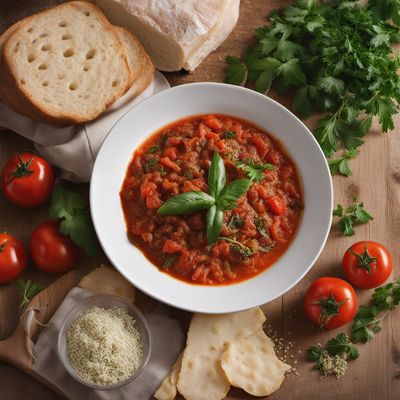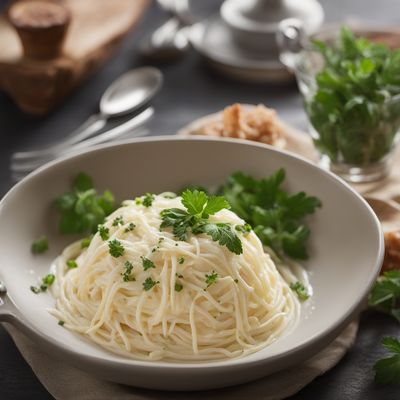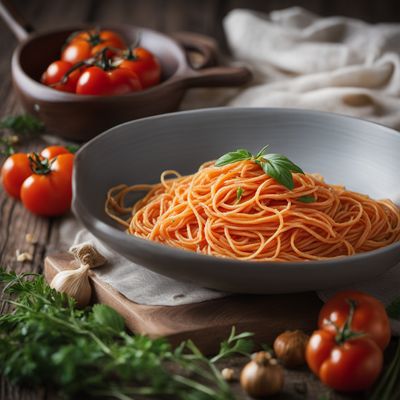
Ingredient
Cheese, pecorino romano
The Bold and Savory Delight: Pecorino Romano Cheese
Pecorino Romano cheese is a hard, aged cheese made from sheep's milk. It has a pale yellow color and a firm, granular texture. The cheese is known for its sharp and salty flavor, with nutty undertones. Its aroma is robust and slightly pungent. Pecorino Romano is often grated or shaved over pasta, salads, and soups, enhancing the overall taste and adding a delightful tanginess.
Origins and history
Pecorino Romano cheese originated in the regions of Lazio, Sardinia, and Tuscany in Italy. It has a rich historical significance, dating back to ancient Roman times when it was a staple in the diet of Roman soldiers. The cheese was highly valued for its long shelf life and nutritional benefits, making it an essential part of their rations during long military campaigns.
Nutritional information
Pecorino Romano cheese is a good source of protein, calcium, and phosphorus. It is also rich in vitamins A and B12. A 1-ounce (28g) serving of Pecorino Romano cheese contains approximately 110 calories.
Allergens
Pecorino Romano cheese is made from sheep's milk and may not be suitable for individuals with lactose intolerance or dairy allergies.
How to select
When selecting Pecorino Romano cheese, look for a well-aged cheese with a firm texture and a pale yellow color. Avoid cheeses with any signs of mold or excessive dryness. Opt for cheese that is sold in whole pieces rather than pre-grated, as it tends to have better flavor and quality.
Storage recommendations
To maintain the freshness and quality of Pecorino Romano cheese, it is best stored in the refrigerator. Wrap the cheese tightly in wax paper or plastic wrap to prevent it from drying out. It can be stored for up to several months if properly sealed.
How to produce
Pecorino Romano cheese is traditionally produced by using sheep's milk, rennet, and salt. The milk is heated, curdled, and then left to ferment and age for several months. The aging process contributes to the cheese's distinct flavor and texture.
Preparation tips
Pecorino Romano cheese is commonly grated or shaved over pasta dishes, such as spaghetti carbonara or cacio e pepe, to add a burst of flavor. It can also be enjoyed on its own or paired with fruits, nuts, or cured meats for a delightful cheese platter. When using Pecorino Romano in recipes, remember that it is a salty cheese, so adjust the amount of salt in the dish accordingly.
Substitutions
A suitable substitute for Pecorino Romano cheese is Parmesan cheese, which shares a similar texture and flavor profile. However, Parmesan has a milder taste, so you may need to add a touch of salt to compensate.
Culinary uses
Pecorino Romano cheese is widely used in Italian cuisine. It is a key ingredient in classic dishes like pasta alla gricia, bucatini all'amatriciana, and saltimbocca. The cheese is also a popular choice for grating over salads, roasted vegetables, and soups, adding a burst of flavor and enhancing the overall taste.
Availability
Pecorino Romano cheese is commonly available in Italy, particularly in the regions of Lazio, Sardinia, and Tuscany. It is also exported and can be found in specialty cheese shops and gourmet grocery stores worldwide.
More ingredients from this category » Browse all

Cheese, afuega'l pitu
The Fiery Delight: Exploring the Bold Flavors of Afuega'l Pitu Cheese

Cheese, sbrinz
The Alpine Delight: Sbrinz Cheese

Cheese, comte
The King of French Cheeses

Cheese, caciocavallo
The Versatile Italian Delight

Cheese, manchego
The Spanish Delight

Cheese, zamorano
The Spanish Delight: Unveiling the Richness of Zamorano Cheese

Cheese, grana padano
The King of Italian Cheeses: Grana Padano

Cheese, ragusano
The Sicilian Delight

Cheese, parmigiano reggiano
The King of Cheeses

Cheese, bitto della valtellina
Bitto della Valtellina: The Alpine Delicacy

Cheese, san simon
The Smoky Delight of San Simon Cheese

Cheese, fiore sardo
The Sardinian Delight: Fiore Sardo Cheese
Recipes using Cheese, pecorino romano » Browse all

Pasta alla Gricia with Pancetta and Pecorino Romano
Savory Delight: Pancetta and Pecorino Pasta alla Gricia

Sardinian-style Rujak Tumbuk
Tropical Fusion: Sardinian-style Rujak Tumbuk

Omani-style Fava Beans with Pecorino Cheese
Savory Omani Fava Beans Delight

Trippa alla Romana with a Twist
Savory Roman-style Tripe Delight

Roman-style Uova Trippate
Eggs in Roman Style: A Creamy Delight

Tiliccas with Tomato and Basil Sauce
Sardinian Delight: Crispy Tiliccas with Fresh Tomato and Basil Sauce

Torta di Pepe di Camaiore
Peppered Delight: A Savory Italian Torta

Pistùm alla Sarda
Sardinian Herb and Cheese Pasta Delight

Rigatoni with Pajata Sauce
Hearty Rigatoni Delight: A Taste of Italian Comfort

Lesotho-style Bottarga Pasta
Savory Lesotho Delight: Bottarga Pasta with a Local Twist

Rianata Trapanese - Sicilian Tomato and Cheese Flatbread
Sicilian Sunshine Flatbread: A Burst of Mediterranean Flavors

Pizza de Pasqua de Civitavecchia
Savory Easter Pizza: A Traditional Italian Delight